I remember the first time
we kissed.
Ah, the electricity, the shock that you created
never felt it since.
The present narrowed to your eyes
and the wonder of your soul.
Sex was just a consummation
inevitable............
never equal
to that moment.
V
I remember the first time
we kissed.
Ah, the electricity, the shock that you created
never felt it since.
The present narrowed to your eyes
and the wonder of your soul.
Sex was just a consummation
inevitable............
never equal
to that moment.
V

D A V I D
Sistine ChapelAll the same, it is the Sistine ceiling that displays Michelangelo at the full stretch of his majesty. Recent cleaning and restoration have exposed this astonishing work in the original vigour of its color. The sublime forms, surging with desperate energy, tremendous with vitality, have always been recognized as uniquely grand. Now these splendid shapes are seen to be intensely alive in their color, indeed shockingly so for those who liked them in their previous dim grandeur.
The story of the Creation that the ceiling spells out is far from simple, partly because Michelangelo was an exceedingly complicated man, partly because he dwells here on profundities of theology that most people need to have spelt out for them, and partly because he has balanced his biblical themes and events with giant ignudi, naked youths of superhuman grace. They express a truth with surpassing strength, yet we do not clearly see what this truth actually is. The meaning of the ignudi is a personal one: it cannot be verbalized or indeed theologized, but it is experienced with the utmost force.
 Creation of the Sun and Moon
Creation of the Sun and Moon  The Separation of Light from the Darkness
The Separation of Light from the Darkness There is the same power, though in more comprehensible form, in the great prophets and seers that sit in solemn niches below the naked athletes. Sibyls were the oracles of Greece and Rome. One of the most famous was the Sibyl of Cumae, who, in the Aeneid, gives guidance to Aeneas on his journey to the underworld. Michelangelo was a heavyweight intellectual and poet, a profoundly educated man and a man of utmost faith; his vision of God was of a deity all ``fire and ice'', terrible, august in His severe purity. The prophets and the seers who are called by divine vocation to look upon the hidden countenance of God have an appropriate largeness of spirit. They are all persons without chitchat in them.
 Delphes Sylphide
Delphes Sylphide  Sybille de Cummes
Sybille de Cummes The Erythraean Sibyl leans forward, lost in her book. The artist makes no attempt to show any of the sibyls in appropriate historical garb, or to recall the legends told of them by the classical authors. His interest lies in their symbolic value for humanity, proof that they have always been the spiritual enlightened ones, removed from the sad confusion of blind time.
The fact that the sibyls originated in a myth, and one dead to his heart (which longed for Christian orthodoxy) only heightens the drama. At some level we all resent the vulnerability of our condition, and if only in image, not reality, we take deep comfort in these godlike human figures. Some of the sibylline seers are shown as aged, bent, alarmed by their prophetic insight.
The implicit sense of God's majesty (rather than His fatherhood) is made explicit in the most alarming Last Judgement known to us. Is is Michelangelo's final condemnation of a world he saw as irredeemably corrupt, a verdict essentially heretical, though at that time is was thought profoundly orthodox. His judging Christ is a great, vengeful Apollo, and the power in this terrible painting comes from the artist's tragic despairs. He paints himself into the judgement, not as an integral person, but as a flayed skin, an empty envelope of dead surface, drained of his personhood by artistic pressure. The only consolation, when even the Virgin shrinks from this thunderous colossus, is that the skin belongs to St Bartholomew, and through this martyr's promise of salvation we understand that perhaps, though flayed alive, the artist is miraculously saved.
As grandly impassive as the Erythraean Sibyl is the heroic Adam in The Creation of Adam, lifting his languid hand to his Creator, indifferent to the coming agonies of being alive.
Sitting in a cold,dreary office
a desk piled with work present past and future,
as life`s seconds tick endlessly onward
My mind returns to you.
Time slows and stops
then reverses, as mental pictures
[the portraits I draw best]
Burst upon the scene;
are hung with care
and gazed upon
in the privacy of my gallery
Vince
IX.
-
HAVE you got a brook in your little heart,
Where bashful flowers blow,
And blushing birds go down to drink,
And shadows tremble so?
-
And nobody knows, so still it flows,
That any brook is there;
And yet your little draught of life
Is daily drunken there;
-
Then look out for the little brook in March,
When the rivers overflow,
And the snows come hurrying from the hills,
And the bridges often go.
-
And later, in August it may be,
When the meadows parching lie,
Beware, lest this little brook of life
Some burning noon go dry!
Now, that`s pretty good. LOL
V
The id,
undifferentiated want,
feels the breast
starts to connect.
The ego,
in service to the id,
defines the world
as its palliate.
The super-ego,
in service to society,
says no to psychopathy
it is here we live.
Vince
c 2004 Deabler, V.T.
To my readers. I have renamed this journal as a tribute to psychologist Dr. Rollo May. His quote "To Grow Is To Be Anxious" has always been my favorite. Most Profound.
V
in his bed
never used to the smells,
paralyzed.
his voice now a blink
of an eye,
his dinner by tube,
breathing assisted.
reading done by an aide
slovenly written magazines
who is this week`s star?
oh, but the memories!
daydreams escape him
into the arms of Mary.
twenty years of love
and desire
wreaking havoc on
unhappiness.
and then the truck
monstrous, growing
crushing them
sending her to heaven
and him to bed.
he used to fear death
and its questions
nevermore.
Vince
c 2004 Deabler, V.T.
Barbara was nervous, wary. "But who are you? What do you want of me?"
The tall man looked kindly into Barbara`s eyes. "I am He who is. Nothing more. I am here to protect you. To give you solace. Gabrielle here, is my gift to you. She will be with you always. Remember her."
"Are you Jesus?"
"I am the Son of Man."
"I`m so confused. What do you want of me?"
"Faith."
"Faith is so hard. Life is so hard. I have no friends, no money, no love. How can I have Faith in You or anything?"
"If you have Faith, then you will have all that you need. Rest assured."
Barbara felt the tears running down her cheeks. Faith and love were so hard for her. Her life had given her so little of these things. Yet she was overwhelmed by this meeting. Could Jesus really love her so much? He would appear to her?
"I appear to everyone, in some way, Barbara" said the tall man. "Yet many choose not to see. Faith is not for the faint of heart. It must be freely given to Me."
Barbara realized that the tall man had known what she was thinking! "Oh, God, forgive me! And I have Faith in you."
"Then you will have all that you need." With that, the tall man seemed to fade, as if a hologram. Gabrielle approached her, touched her hand. And Barbara felt a melding, a blending. She felt peaceful and fell asleep.
Vince
c 2004 Deabler, V.T.
That evening, the two figures appeared as usual, standing to the right of the bed. Instead of lying there passively, Barbara abruptly pulled herself up and sat on the side of the bed closest to them. "Who are you? Why are you here?" she asked.
The dark man turned his body to her and raised his head slightly, enough that she glimpsed his face. His eyes were blue and kindly and the smile on his lips allowed her heart to slow.
"We are here because you summoned us, Barbara. Please don`t be afraid."
"But who are you, how did I ask for you?"
"We are always here. We are always everywhere, at everyone`s side. Waiting to be beckoned, to be seen. Most people, late at night, have seen us. But most people are not as open to us as you, Barbara. For most people, we are seen only for a split second, when they awaken in the middle of the night, perhaps from a dream. As they open their eyes, we appear; they see us and startle. Most of them dismiss us and turn us into shadows, a dress laying on a chair, a coat hanging in a dark closet. People have that power. Others are frightened and turn on their bedside lamps in order to drive away the shadows, drive away their fear of us. But we are always there."
"And there are the special people, like you, Barbara. Those who open their eyes at night but also open their minds. Who lie awake and wait for us, looking in the shadows. And to them do we appear."
c 2004 Deabler, V.T.
It`s only at night, when shadows come alive.
Barbara worked at "All-nite Diner", and the thought of walking home always gave pause. Jamesford was an old town, sustaining its self by its proximity to the interstate. Barbara had grown up here, the fourth generation of Irish stock; like most girls growing up in small towns, she had had her dreams.
Senior year of high school, her English teacher had encouraged her writing. Mrs. Abrams praised her bright mind, her imagination. In twelve years of school she had been very lonely, had only the friends that presented themselves at night, that seemed to materialize next to her bed.
At first, she would close her eyes and cry out to her mother, who would rush in to comfort her. "Bobbie, it`s ok, only a dream" her mother would say, holding her in her arms. As Barbara grew older and her mother responded to her angrily, more dismissively, the nightly visits becoming tiresome, Barbara first felt the terror of loneliness.
She prayed to God to spare her these dreams, yet even in the midst of her supplications she felt their reality. The two figures stood before her each night, unspeaking. One of the figures was a child, perhaps four or five. Very silent, her face blank, a slight downturn to the lips. She seemed within herself, by herslf, lonely.
The other figure was ephemeral in its blackness. It seemed a man, tall, dressed in black, a hat pulled down concealing his eyes. It seemed not real next to the child, its figure vacillating between distinct and something else. Something that reminded her of a Hologram, like Princess Leiah in "Star Wars", something from the past.
After many, many visits there came a time when Barbara became bolder. The figures must be here for some reason! She must find out what was their meaning, why they appeared to her each night.
c 2004 Deabler, V.T.
In dreams and reverie
Life is refreshed by want.
All are born to the purple
Beautiful, serene.
The bashful become flirtatious
the needy, sated.
Death seems surmountable
As blackness is blanched by light.
c 2004 Deabler, V.T.
Now I know how hard it is to be a Judge! It was great fun to read and loudly laugh at all of the great entries. Thanks to all! And now, the new Quipster Title Holder!
It was only after he moved in that Joe remembered the first three rules of real estate -- location, location and location.
Comment from sistercdr - 11/24/04 6:22 AM
Sistercdr will post the next photo for our captions. Congratulations and thanks to all Master Quipsters.
Vince
Donah of "Hippies in Yuppieland" has passed me the "Quipster" baton!!
Thanks, Amy.
Here`s the new Pic!!
Please enter your Quip [caption] response to the picture either in comments or link it to your journal. I`ll choose a winner Friday.
Vince
Thank you, Carly, Alan and, especially, Elvis for selecting me as November`s Recipient of the "Maddie" Madlibs award!
I have posted my reward, an original Ondinemonet Photograph!!!
The Photo was a perfect choice for me. When I was young, Jack Kerouac was, at one time, my favorite contemporary writer.
Please everyone, join the fun! The next Madlibs contest will be posted on December 10, 2004. So please stop by Ondinemonet`s wonderful Journal "ELLIPSIS" before then!
Thanks,
Vince
The nights are endless, yet
an inkling, a spark is kindled
from the beauty
a lens allowed her.
In reverie, she thinks
of butterflies and flowers
of children`s smiles
of moonlit nights
and stars divine.
Awakened with a start,
a smile upon her lips,
she stretches like a kitten
her thoughts in happiness.
Perhaps the camera
brings focus to her life
What is gone is done
and Art is happiness.
V
c 2004 Deabler, V.T.
There`s something wrong with her
A certain sadness, lingers in the air
Pronounces her passing,
as clouds conceal the warming rays.
Lifelong burdens, never truly gone,
The grimace in her sometimes smile
reveals the weight of destiny.
People question her activity
the glee she sees in camera`s lens
captured one by one
and every day a symphony.
Yet lying down at night, alone
awaiting Somnus` divine repose
She cannot help but think of things,
denying life its happiness.
V
c 2004 Deabler, V.T.
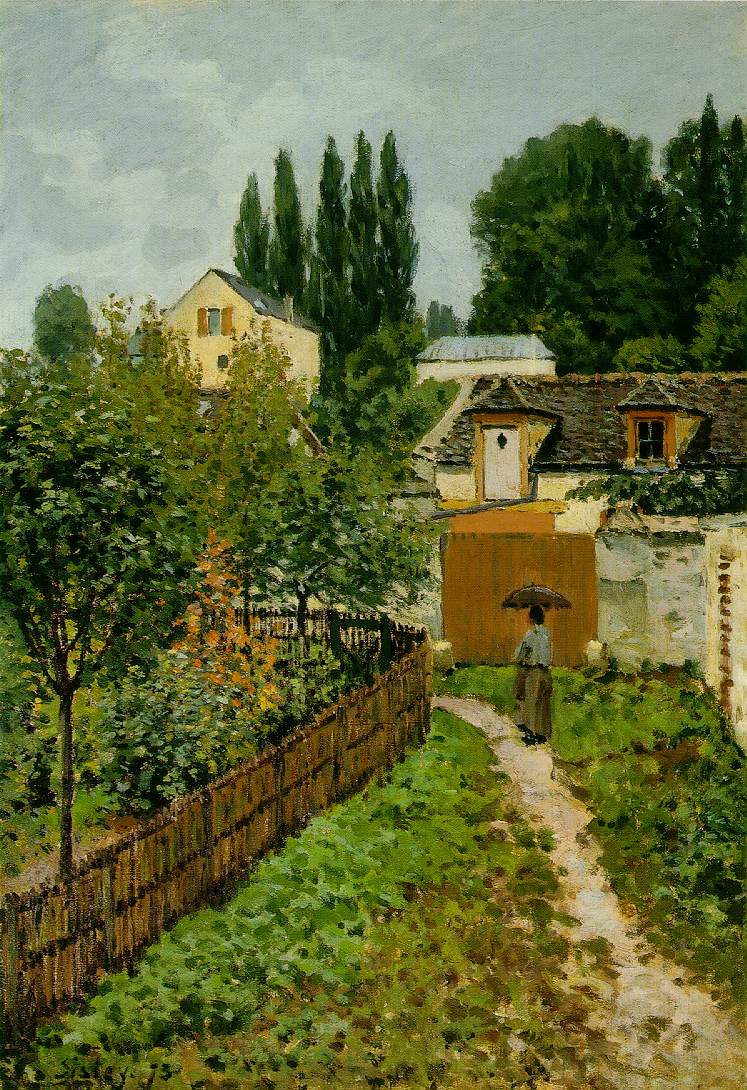
![]()
Sisley, Alfred (b. Oct. 30, 1839, Paris, Fr.--d. Jan. 29, 1899, Moret-sur-Loing), painter who was one of the creators of French Impressionism.
Sisley was born in Paris of English parents. After his schooldays, his father, a merchant trading with the southern states of America, sent him to London for a business career, but finding this unpalatable, Sisley returned to Paris in 1862 with the aim of becoming an artist. His family gave him every support, sending him to Gleyre's studio, where he met Renoir, Monet and Bazille. He spent some time painting in Fontainebleau, at Chailly with Monet, Bazille and Renoir, and later at Marlotte with Renoir. His style at this time was deeply influenced by Courbet and Daubigny, and when he first exhibited at the Salon in 1867 it was as the pupuil of Corot.
By this time, however, he had started to frequent the Café Guerbois, and was becoming more deeply influenced by the notions which were creating Impressionism. During the Franco-Prussian war and the period of the Commune, he spent some time in London and was introduced to Durand-Ruel by Pissarro, becoming part of that dealer's stable. In the mean time, his father had lost all his money as a result of the war, and Sisley, with a family to support, was reduced to a state of penury, in which he was to stay until virtually the end of his life.
He now saw himself as a full-time professional painter and part of the Impressionist group, exhibiting with them in 1874, 1876, 1877 and 1882. His work had by this time achieved complete independance from the early influences that had affected him. In the 1870s he produced a remarkable series of landscapes of Argenteuil, where he was living, one of which, The Bridge at Argenteuil (1872; Brooks Memorial Gallery, Memphis, USA) was bought by Manet. Towards the end of the decade Monet was beginning to have a considerable influence on him, and a series of landscape paintings of the area around Paris, including Marly, Bougival and Louveciennes (1876; Floods at Port-Marly, Musée d'Orsay), shows the way in which his dominent and evident lyricism still respects the demands of the subject-matter. From his early admiration for Corot he retained a passionate interest in the sky, which nearly always dominates his paintings, and also in the effects of snow, the two interests often combining to create a strangely dramatic effect (1880; Snow at Véneux; Musée d'Orsay). Naturally different, he did not promote himself in the way that some of his fellow Impressionists did, and it was only towards the end of his life, when he was dying of cancer of the throat, that he received something approaching the recognition he deserved.
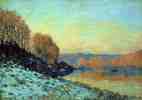 The Seine at Bougival in Winter
The Seine at Bougival in Winter
1872; Museum of Fine Arts, Lille
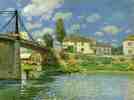 Bridge at Villeneuve-la-Garenne
Bridge at Villeneuve-la-Garenne
1872 (170 Kb); Oil on canvas, 49.5 x 65.4 cm; Metropolitan Museum of Art, New York
 Garden Path in Louveciennes (Chemin de l'Etarche)
Garden Path in Louveciennes (Chemin de l'Etarche)
1873 (210 Kb); Oil on canvas, 64 x 46 cm; Private collection
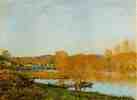 L'automne: Bords de la Seine pres Bougival (Autumn: Banks of the Seine near Bougival)
L'automne: Bords de la Seine pres Bougival (Autumn: Banks of the Seine near Bougival)
1873 (170 Kb); Oil on canvas, 46 x 62 cm (18 1/4 x 24 5/16"); Museum of Fine Arts, Montreal
 Snow at Louveciennes
Snow at Louveciennes
1874 (240 Kb); Oil on canvas, 55.9 x 45.7 cm; Phillips Collection, Washington, DC
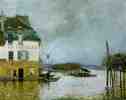 Flood at Port-Marly
Flood at Port-Marly
1876 (160 Kb); Oil on canvas, 50 x 61 cm; Musee des Beaux-Arts, Rouen
![]() Boat in the Flood at Port-Marly
Boat in the Flood at Port-Marly
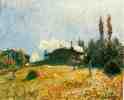 Station at Sevres
Station at Sevres
c. 1879 (200 Kb); Oil on canvas, 15 x 22 cm; Private collection
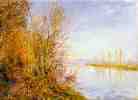 The Chemin de By through Woods at Roches-Courtaut, St. Martin's Summer
The Chemin de By through Woods at Roches-Courtaut, St. Martin's Summer
1880 (180 Kb); Oil on canvas, 60 x 81 cm (23 1/2 x 32"); Museum of Fine Arts, Montreal
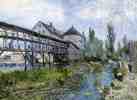 Provencher's Mill at Moret
Provencher's Mill at Moret
1883 (230 Kb); Oil on canvas, 54 x 73 cm; Museum Boymans-van Beuningen, Rotterdam
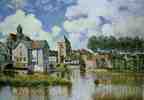 Moret-sur-Loing
Moret-sur-Loing
1891 (220 Kb); Oil on canvas, 65 x 92 cm; Galerie H. Odermatt-Ph. Cazeau, Paris
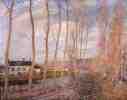 The Canal of Loing at Moret
The Canal of Loing at Moret
1892; Musée d'Orsay, Paris
 The Church at Moret
The Church at Moret
1894 (160 Kb); Oil on canvas, 100 x 81 cm; Musee du Petit Palais, Paris
Photographs by Mark Harden.
© 16 Jul 2002, Nicolas Pioch -
Carly, I hope you like the entry. V
Readers, click on any thumbnail to see large Painting.
in dreams,
Signs appear.
Omens of another place.
Skies of rainbows
blind our vision,
a Golden warmth
to kiln our bones.
Chilliness, ugly sounds
invade our senses,
Hades` spawn
laugh derisively.
Age brings us
in nightly battles
to the mirror of our destiny.
Only faith can warm our hearts.
Vince
c 2004 Deabler, V.T.
My journal has been in existence for more than a year and I have never written an entry remotely political. However, in listening to the barrage of advertising on radio and television, from local to regional to national, I am again reminded of one point that rankles me. That is, the acceptance of the word "Liberal" as defining something that is negative and, somehow, to be avoided like Communism or Nazism.
I would like to quote from the Introductory to "The History of Western Philosophy" by the great English Philosopher Bertrand Russell. [pg. xxiii, Introductory]
"In general, important civilizations start with a rigid and superstitious system, gradually relaxed, and leading, at a certain stage, to a period of brilliant genius, while the good of the old tradition remains and the evil inherent in its dissolution has not yet developed. But, as the evil unfolds, it leads to anarchy, thence, inevitably, to a new tyranny, producing a new synthesis secured by a new system of dogma. The doctrine of liberalism is an attempt to escape from this endless oscillation. The essence of liberalism is an attempt to secure a social order not based on irrational dogma, and insuring stability without involving more restraints than are necessary for the preservation of the community. Whether this attempt can succeed only the future can determine."
V
Gottfried Burger
" Lenore "
[ last six stanzas ]
How flew the moon high overhead,
In the wild race madly driven!
In and out, how the stars danced about,
And reeled o'er the flashing heaven!
"What ails my love? the moon shines bright:
Bravely the dead men ride thro' the night.
Is my love afraid of the quiet dead?"
"Alas! let them alone in their dusty bed!"
"Horse, horse! meseems 'tis the cock's shrill note,
And the sand is well nigh spent;
Horse, horse, away! 'tis the break of day, -
'Tis the morning air's sweet scent.
Finished, finished is our ride:
Room, room for the bridegroom and the bride!
At last, at last, we have reached the spot,
For the speed of the dead man has slackened not!"
And swiftly up to an iron gate
With reins relaxed they went;
At the rider's touch the bolts flew back,
And the bars were broken and bent;
The doors were burst with a deafening knell,
And over the white graves they dashed pell mell:
The tombs around looked grassy and grim,
As they glimmered and glanced in the moonlight dim.
But see! But see! in an eyelid's beat,
Towhoo! a ghastly wonder!
The horseman's jerkin, piece by piece,
Dropped off like brittle tinder!
Fleshless and hairless, a naked skull,
The sight of his weird head was horrible;
The lifelike mask was there no more,
And a scythe and a sandglass the skeleton bore.
Loud snorted the horse as he plunged and reared,
And the sparks were scattered round: -
What man shall say if he vanished away,
Or sank in the gaping ground?
Groans from the earth and shrieks in the air!
Howling and wailing everywhere!
Half dead, half living, the soul of Lenore
Fought as it never had fought before.
The churchyard troop, - a ghostly group, -
Close round the dying girl;
Out and in they hurry and spin
Through the dancer's weary whirl:
"Patience, patience, when the heart is breaking;
With thy God there is no question-making:
Of thy body thou art quit and free:
Heaven keep thy soul eternally!"
called to dinner,
the boy and girl descend
from their bedrooms
where they must stay
in grandma`s house.
quietly, they pass the
dining room
through the kitchen
where grown-ups eat
to the shed.
unheated
quickly
they eat
in grandma`s house.
c2004 Deabler, V.T.
First, I`d like to thank the Editors for selecting this journal as a weekly pick.
Second, Thanks to all who have taken the time to send Congrats.
Third, and most importantly, I deeply bow to my many friends who make the AOL J community such an enriching place.
It was serendipity that allowed my homage to journallers to be my current post when the Weekly Picks were announced.
Vince
The need to express ourselves
draws some of us to poetry.
It suppresses consciousness
replaces it with simile.
Art explodes
in watercolor and oil.
Cameras divine
the poetry of nature.
Journallers delight
in tales of family life.
Children smile
cats and dogs cavort.
Suspenseful tales
and those of passion
Share their words,
with readers gasping.
c 2004 Deabler, V.T.
Leonardo DA VINCI (b. 1452, Vinci, Republic of Florence [now in Italy]--d. May 2, 1519, Cloux, Fr.), Italian painter, draftsman, sculptor, architect, and engineer whose genius, perhaps more than that of any other figure, epitomized the Renaissance humanist ideal. His Last Supper (1495-97) and Mona Lisa (1503-06) are among the most widely popular and influential paintings of the Renaissance. His notebooks reveal a spirit of scientific inquiry and a mechanical inventiveness that were centuries ahead of his time.
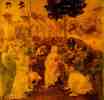 The Adoration of the Magi
The Adoration of the Magi
1481-82 (200 Kb); Yellow ochre and brown ink on panel, 246 x 243 cm (8 x 8 ft); Uffizi, Florence
 Lady with an Ermine
Lady with an Ermine
1483-90 (150 Kb); Oil on wood, 53.4 x 39.3 cm (21 x 15 1/2 in); Czartoryski Museum, Cracow
 Madonna Litta
Madonna Litta
c. 1490-91 (150 Kb); Tempera on canvas, transferred from panel, 42 x 33 cm (16 1/2 x 13 in); Hermitage, St. Petersburg
By a happy chance, a common theme links the lives of four of the famous masters of the High Renaissance -- Leonardo, Michelangelo, Raphael and Titian. Each began his artistic career with an apprenticeship to a painter who was already of good standing, and each took the same path of first accepting, then transcending, the influence of his first master. The first of these, Leonardo da Vinci (1452-1519), was the elder of the two Florentine masters. He was taught by Andrea del Verrocchio (1435-88), an engaging painter whose great achievement was his sculpture. Verrochio also had considerable influence on the early work of Michelangelo. Verrocchio's best-known painting is the famous Baptism of Christ, famous because the youthful Leonardo is said to have painted the dreamy and romantic angel on the far left, who compares more than favorably with the stubby lack of distinction in the master's owm angel immediately beside him.
Leonardo: Renaissance polymath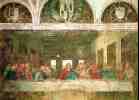 The Last Supper
The Last Supper
1498 (180 Kb); Fresco, 460 x 880 cm (15 x 29 ft); Convent of Santa Maria delle Grazie (Refectory), Milan
There has never been an artist who was more fittingly, and without qualification, described as a genius. Like Shakespeare, Leonardo came from an insignificant background and rose to universal acclaim. Leonardo was the illegitimate son of a local lawyer in the small town of Vinci in the Tuscan region. His father acknowledged him and paid for his training, but we may wonder whether the strangely self-sufficient tone of Leonardo's mind was not perhaps affected by his early ambiguity of status. The definitive polymath, he had almost too many gifts, including superlative male beauty, a splendid singing voice, magnificent physique, mathematical excellence, scientific daring... the list is endless. This overabundance of talents caused him to treat his artistry lightly, seldom finishing a picture, and sometimes making rash technical experiments. The Last Supper, in the church of Santa Maria delle Grazie in Milan, for example, has almost vanished, so inadequate were his innovations in fresco preparation.
 A copy made by an apprentice of a da Vinci painting which never dried
A copy made by an apprentice of a da Vinci painting which never dried
Da vinci made numerous experiments using different colours and when painting this particular church he failed.
Yet the works what we have salvaged remain the most dazzingly poetic pictures ever created. The Mona Lisa has the innocent disavantage of being too famous. It can only be seen behind thick glass in a heaving crowd of awe-stuck sightseers. It has been reproduced in every conceivable medium: it remains intact in its magic, for ever defying the human insistence on comprehending. It is a work that we can only gaze at in silence.
Leonardo's three great portraits of women all have a secret wistfulness. This quality is at its most appealing in Cecilia Gallarani, at its most enigmatic in the Mona Lisa, and at is most confrontational in Ginevra de' Benci. It is hard to gaze at the Mona Lisa, because we have so many expectations of it. Perhaps we can look more truly at a less famous portrait, Ginevra de' Benci. It has that haunting, almost unearthly beauty peculiar to Leonardo.
A withheld identity Ginevra de' Benci
Ginevra de' Benci
c. 1474 (150 Kb); Oil on wood, 38.2 x 36.7 cm (15 1/8 x 14 1/2 in); National Gallery of Art, Washington, DC
The subject of Ginevra de' Benci has nothing of the Mona Lisa's inward amusement, and also nothing of Cecilia's gentle submissiveness. The young woman looks past us with a wonderful luminous sulkiness. Her mouth is set in an unforgiving line of sensitive disgruntlement, her proud and perfect head is taut above the unyielding column of her neck, and her eyes seem to narrow as she endures the painter and his art. Her ringlets, infinitely subtle, cascade down from the breadth of her gleaming forehead (the forehead, incidentally, of one of the most gifted intellectuals of her time). These delicate ripples are repeated in the spikes of the juniper bush.
The desolate waters, the mists, the dark treess, the reflected gleams of still waves, all these surround and illuminate the sitter. She is totally fleshly and totally impermeable to the artist. He observes, rapt by her perfection of form, and shows us the thin veil of her upper bodice and the delicate flushing of her throat. What she is truly like she conceals; what Leonardo reveals to us is precisely this concealment, a self-absorption that spares no outward glance.
Interior depth The Virgin of the Rocks
The Virgin of the Rocks
1503-06 (140 Kb); Oil on wood, 189.5 x 120 cm (6 x 4 ft); National Gallery, London
We can always tell a Leonardo work by his treatment of hair, angelic in its fineness, and by the lack of any rigidity of contour. One form glides imperceptibly into another (the Italian term is sfumato), a wonder of glazes creating the most subtle of transitions between tones and shapes. The angel's face in the painting known as the Virgin of the Rocks in the National Gallery, London, or the Virgin's face in the Paris version of the same picture, have an interior wisdom, an artistic wisdom that has no pictorial rival.
This unrivalled quality meant that few artists actually show Leonardo's influence: it is as if he seemed to be in a world apart from them. Indeed he did move apart, accepting the French King François I's summons to live in France. Those who did imitate him, like Bernardini Luini of Milan (c.1485-1532) caught only the outer manner, the half-smile, the mistiness.
The shadow of a great genius is a peculiar thing. Under Rembrandt's shadow, painters flourished to the extent that we can no longer distinguish their work from his own. But Leonardo's was a chilling shadow, too deep, too dark, too overpowering.
Possession
Listen as the wind blows from across the great divide
voices trapped in yearning, memories trapped in time
the night is my companion, and solitude my guide
would I spend forever here and not be satisfied?
And I would be the one
to hold you down
kiss you so hard
I'll take your breath away
and after, I'd wipe away the tears
just close your eyes dear
Through this world I've stumbled
so many times betrayed
trying to find an honest word to find
the truth enslaved
oh you speak to me in riddles
and you speak to me in rhymes
my body aches to breathe your breath
your words keep me alive
And I would be the one
to hold you down
kiss you so hard
I'll take your breath away
and after, I'd wipe away the tears
just close your eyes dear
Into this night I wander
it's morning that I dread
another day of knowing of
the path I fear to tread
oh into the sea of waking dreams
I follow without pride
nothing stands between us here
and I won't be denied
And I would be the one
to hold you down
kiss you so hard
I'll take your breath away
and after, I'd wipe away the tears
just close your eyes.
EARLY AUTUMN
When an early autumn walks the land and chills the breeze
and touches with her hand the summer trees,
perhaps you'll understand what memories I own.
There's a dance pavilion in the rain all shuttered down,
a winding country lane all russet brown,
a frosty window pane shows me a town grown lonely.
That spring of ours that started so April-hearted,
seemed made for just a boy and girl.
I never dreamed, did you, any fall would come in view
so early, early.
Darling if you care, please, let me know,
I'll meet you anywhere, I miss you so.
Let's never have to share another early autumn.
This wonderful poem was written for me for my Birthday, which is Today. Thank You, Love.
Abyss
O intrepid sojourner
in the labyrinth
No timorous soul yours
careening into the abyss
Explore the depths
Gather sharp objects
With effort
Emerge courageous still
With hunger devour
Beauty
With wisdom
appreciate Love
c 2004 Cass, S.
KISMET
"And This Is My Beloved"
Lyrics: Robert Wright + George Forrest
Book: Luther Davis + Charles Lederer
Premiere: Thursday, December 3, 1953
Dawn's promising skies
Petals on a pool drifting
Imagine these in one pair of eyes
And this is my beloved
Strange spice from the south
Honey through the comb sifting
Imagine these in one eager mouth
And this is my beloved
And when s/he speaks and when s/he talks to me
Music! Mystery!
And when s/he moves And when s/he walks with me
Paradise comes suddenly near
All that can stir All that can stun
All that's for the heart's lifting
Imagine these in one perfect one
And this is my beloved
And this is my beloved.
At the Request of sistercdr, here is a favorite poem by W.H. Auden.
Funeral Blues
Stop all the clocks, cut off the telephone,
Prevent the dog from barking with a juicy bone,
Silence the pianos and with muffled drum
Bring out the coffin, let the mourners come.
Let aeroplanes circle moaning overhead
Scribbling on the sky the message He Is Dead,
Put crepe bows round the white necks of the public doves,
Let the traffic policemen wear black cotton gloves.
He was my North, my South, my East and West,
My working week and my Sunday rest,
My noon, my midnight, my talk, my song;
I thought that love would last for ever; I was wrong.
The stars are not wanted now: put out every one;
Pack up the moon and dismantle the sun;
Pour away the ocean and sweep up the wood,
For nothing now can ever come to any good.
W. H. Auden
The Heaven of Animals
Here they are. The soft eyes open.
If they have lived in a wood
It is a wood.
If they have lived on plains
It is grass rolling
Under their feet forever.
Having no souls, they have come,
Anyway, beyond their knowing.
Their instincts wholly bloom
And they rise.
The soft eyes open.
To match them, the landscape flowers,
Outdoing, desperately
Outdoing what is required:
Thr richest wood,
The deepest field.
For some of these,
It could not be the place
It is, without blood.
These hunt, as they have done
But with claws and teeth grown perfect,
More deadly than they can believe.
They stalk more silently,
And crouch on the limbs of trees,
And their descent
Upon the bright backs of their prey
May take years
In a sovereign floating of joy.
And those that are hunted
Know this as their life,
Their reward: to walk
Under such trees in full knowledge
Of what is in glory above them,
And to feel no fear,
But acceptance, compliance.
Fulfilling themselves without pain
At the cycles center,
They tremble, they walk
Under the tree,
They fall, they are torm,
They rise, they walk again.
James Dickey 1961
Finally, The Philadelphia Eagles` Year!!!!!!
{ We Hope }!!!!!!!!!!!!!!!!!!!!!!!!!
Graphic courtesy of my son, Sean.
To rise above
the storming winds
beset
by circumstance.
The measure of a woman
if all were fashioned
with equal measure.
If not for a poem
is suffering worthwhile.
C 2004 Deabler, V.T.
For only the second time, I`d like to pimp a journal. My favorite AOL Journal fiction writer. She is starting a new story, this one more personal [ though all of her tales are personal ]. I hope you`ll take the time for her writing....It`s wonderful!
Vince
here is the link.
http://journals.aol.com/barbpinion/THERESTOFTHESTORY/entries/1280
Matisse, Master of Color
The art of our century has been dominated by two men: Henri Matisse and Pablo Picasso. They are artists of classical greatness, and their visionary forays into new art have changed our understanding of the world. Matisse was the elder of the two, but he was a slower and more methodical man by temperament and it was Picasso who initially made the greater splash. Matisse, like Raphael, was a born leader and taught and encouraged other painters, while Picasso, like Michelangelo, inhibited them with his power: he was a natural czar.
Matisse's artistic career was long and varied, covering many different styles of painting from Impressionism to near Abstraction. Early on in his career Matisse was viewed as a Fauvist, and his celebration of bright colors reached its peak in 1917 when he began to spend time on the French Riviera at Nice and Vence. Here he concentrated on reflecting the sensual color of his surroundings and completed some of his most exciting paintings. In 1941 Matisse was diagnosed as having duodenal cancer and was permanently confined to a wheelchair. It was in this condition that he completed the magnificent Chapel of the Rosary in Vence.
Matisse's art has an astonishing force and lives by innate right in a paradise world into which Matisse draws all his viewers. He gravitated to the beautiful and produced some of the most powerful beauty ever painted. He was a man of anxious temperament, just as Picasso, who saw him as his only rival, was a man of peasant fears, well concealed. Both artists, in their own fashion, dealt with these disturbances through the sublimation of painting: Picasso destroyed his fear of women in his art, while Matisse coaxed his nervous tension into serenity. He spoke of his art as being like ``a good armchair''-- a ludicrously inept comparison for such a brilliant man-- but his art was a respite, a reprieve, a comfort to him.
Matisse initially became famous as the ``King of the Fauves'', an inappropriate name for this gentlemanly intellectual: there was no wildness in him, though there was much passion. He is an awesomely controlled artist, and his spirit, his mind, always had the upper hand over the ``beast'' of Fauvism.
 Notre-Dame, une fin d'après-midi (A Glimpse of Notre Dame in the Late Afternoon)
Notre-Dame, une fin d'après-midi (A Glimpse of Notre Dame in the Late Afternoon)  Le bonheur de vivre (The Joy of Life)
Le bonheur de vivre (The Joy of Life)  Flowers in a Pitcher
Flowers in a Pitcher  Mme Matisse: Madras Rouge (The Red Madras Headress)
Mme Matisse: Madras Rouge (The Red Madras Headress)  Le Rifain assis (Seated Riffian)
Le Rifain assis (Seated Riffian)  La leçon de musique (The Music Lesson)
La leçon de musique (The Music Lesson)  Seated Figure, Tan Room
Seated Figure, Tan Room  Two Figures Reclining in a Landscape
Two Figures Reclining in a Landscape  Robe violette et Anemones
Robe violette et Anemones  La Musique
La Musique  Deux fillettes, fond jaune et rouge (Two Girls in a Yellow and Red Interior)
Deux fillettes, fond jaune et rouge (Two Girls in a Yellow and Red Interior)  Water Lilies (The Clouds)
Water Lilies (The Clouds)  Water Lilies
Water Lilies  Waterlilies, Green Reflection, Left Part
Waterlilies, Green Reflection, Left Part Please click on Painting to view large size.
